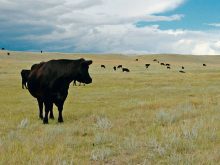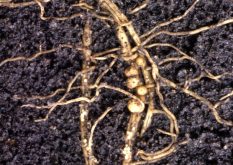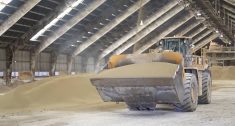Dear Dairy Diary, June 24, 2024: I received a call from a dairy producer who milks about 200 dairy cows. Several of his lactating cows were lethargic, quit eating and milking and had severe diarrhea.
The producer moved a bubbly loose pile with his boot and noticed a lot of undigested corn and what seemed to be pieces of sausage casings. Within a few hours, it was discovered the normal portion of grain had been doubled to 18 kg per head and added to the TMR for the previous couple of days. Luckily, no cows died. This serious error of “grain overload” resulted in a rare case of acute clinical acidosis — not to be confused with subacute ruminal acidosis (SARA) in lactating dairy cows.
READ MORE: Signs of acidosis aren’t always clear
Read Also

Gentle treatments for pain in the neck
Heading toward year-end, people unknowingly tense up against the cold and busyness, causing neck pain that can often be treated with appropriate support and gentle mobility, athletic therapist Kathlyn Hossack says.
SARA, which often occurs in other barns, is a lot more subtle. It’s caused primarily by inadequate forage fibre intake and subsequent insufficient fermentation in the rumen.
Such dietary misfortune leads to lower saliva production and an enlarged pool of lactic acid. Together they cause depression of rumen bicarbonate-buffering capacity. After this takes place, it doesn’t take long for rumen-fluid pH to fall below 6.0, which underlies poor dry matter intakes, poor diet fermentation, frequent digestive upsets and depressed milk and milk fat production as well as body condition and reproduction problems.
Dear Dairy Diary, April Fool’s Day, 1984
I learned, a long time ago, that SARA can be an occasional or chronic problem in lactating dairy cows, but can be controlled by constant vigilance to maintain an effective forage foundation in daily TMR diets, such as:
- 28 per cent neutral detergent fibre (NDF). Seventy-five per cent of this NDF comes from forage sources or equivalent sources (21-22 per cent eNDF). Note: it is not necessarily the wide ratio of forage-to-concentrate that maintains good rumen function.
- Forages chopped at a cut length of half an inch, to provide 15-20 per cent of dietary particles being over 1.5 inches long, creates a good floating mat in the rumen.
- The non-fibrous carbohydrate (NFC) portion of the diet should be limited to 35-37 per cent of the total diet. Starch, which comprises a significant portion of NFC should be targeted at 21-25 per cent of the diet, dry matter (DM).
Dear Dairy Diary, Nov. 22, 2022
I was presented a challenge at a 150-cow dairy to balance a high-milk and -milk fat lactating TMR. It initially contained a 67:33 forage-to-concentrate ratio yet still struggled to have enough effective forage fibre to maintain healthy rumens. Its main limiting factor was a corn silage analysis that showed relatively low NDF of high digestibility, as well as a starch level of 32.6 per cent and NFC of 47.1 per cent.
I reformatted the lactation diet in the best way I could:
- Corn silage was limited to about 10 kg, DM, to limit its starch/NFC intake.
- Grain corn was cut back to 3.6 kg to do the same.
- Adding more alfalfa hay raised forage fibre levels, but its mediocre eNDF and high-soluble protein may have reduced its effectiveness.
- High-fat canola meal was limited to curb its vegetable oil intake, and
- Beet pulp was added at 1.5 kg.
As a result, milk production and milk fat yield remained the same; however, dry matter intake amongst the cows became more consistent.
Dear Dairy Diary, Aug. 28, 2020
I started working with a 150-lactating dairy cow herd this May, which had a variety of production and health challenges. I didn’t link them to an underlying SARA issue until about two months later.
That’s because these lactating dairy cows did not exhibit any of major classic signs of SARA: There were no “on-feed, off-feed” issues caused by acidotic digestive upsets. The total mixed ration (TMR) appeared to have adequate forage fibre. Most of the cows showed cud-chewing activity and no evidence of “sorting” of the daily TMR by the dairy cows. The only odd things were that milk fat production stalled at 3.81 per cent and the average cow’s manure was brick-hard.
I made the following four changes to the lactation diet:
- Replaced 25 per cent of high acid detergent fibre (ADF) alfalfa-grass silage with some finer-stem leafy alfalfa-grass hay,
- Lowered the amount of grain from 15 to 12 lbs.,
- Added two lbs. of ground beet pulp, a source of digestible pectin fibre, and
- Replaced 50 per cent of the barley with 50 per cent steam-flaked corn mixed with five per cent molasses.
In the end it took a few weeks to implement all these changes, and the cows responded with no significant change to dry matter intake and milk yield, but their milk fat responded, to 4.01 per cent, and most new manure piles became a healthy and porridge-like.
Dear Dairy Diary, Sept. 24, 2024
The last two diary entries are actual cases of mine, visiting two different dairy farms where I suspected SARA. In each case, a lack of effective forage fibre in the lactation diets was my strongest feeling as to the underlying cause of SARA. Any of my attempts to reformulate their respective lactation diets — to increase the amount of effective fibre — resulted in subtle improvements among the lactating cows. That’s how long-term solutions to combat SARA tend to work.
















